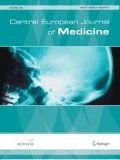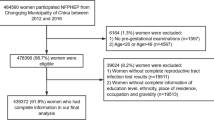Abstract
Hungarian Preconceptional Care includes the preconceptional screening of sexually transmitted infections/disorders (STD) and vaginal candidosis of potential mothers and pyospermia of potential fathers. The aim of this study was to evaluate the effect of this screening and treatment for the rate of preterm births. Clinical and subclinical vaginal candidiasis (asymptomatic candida colonisation), combination of STD and vaginal candidiasis, STD without vaginal candidiasis, finally women without STD and vaginal candidiasis as references were evaluated in 4,672 pregnant women. The association of STD in pregnant women with higher risk of preterm birth was confirmed. However, an association was also found between clinically diagnosed vaginal candidiasis, asymptomatic candida colonisation, and a higher risk for preterm births. This risk was reduced with clotrimazole treatment. However, pregnant women without recognized STD and/or vaginal candidiasis had a higher risk for preterm birth than pregnant women with STD or vaginal candidiasis after appropriate treatment. Thus the conclusion of the study is that the preconceptional screening of STD and vaginal candidiasis followed by appropriate treatment is important to prevent a certain part of preterm birth but it is necessary to improve the efficacy of the previously used methods for this screening.
Similar content being viewed by others
References
Czeizel AE, Dobo M, Dudas I et al.: The Hungarian Periconceptional Service as a model for community genetics. Community Genetics 1998, 1, 252–259
Czeizel AE: Ten years’ experience in periconception care. Eur J Obstet Gynecol Reprod Biol 1999, 84, 43–49
Czeizel AE: Periconceptional Care: An experiment in community genetics. Community Genetics 2000, 3, 119–123
Czeizel AE, Dudás I: Prevention of the first occurrence of neural-tube defects by periconceptional vitamin supplementation. N Engl J Med 1992, 328, 1832–1835
Czeizel AE, Dudás I, Métneki J: Pregnancy outcomes in a randomised controlled trial of periconceptional multivitamin supplementation. Final results. Arch Gynecol Obstet 1994, 255, 131–139
Czeizel AE: Prevention of congenital abnormalities by periconceptional multivitamin supplementation. Br Med J 1993, 306, 1645–1648
Czeizel AE: Reduction of urinary tract and cardiovascular defects by periconceptional multivitamin supplementation. Am J Med Genet 1997, 62, 179–183
Czeizel AE, Dobo M, Vargha P: Hungarian cohort controlled trial of periconceptional multivitamin supplementation shows a reduction in certain congenital abnormalities. Birth Defects Res (Part A) 2004, 70, 853–861
Czeizel AE: Periconceptional folic acid and multivitamin supplementation for the prevention of neural tube defects and other congenital abnormalities. Birth Defects Res (Part A) 2009, 85, 260–268
Gönczy L, Czeizel AE: Integrating smoking cessation into periconception care. Tob Control 1996, 5, 160–161
Czeizel AE, Dudás I, Fritz G: The check-up of reproductive heath and genetic counseling. Genet Counsel 1992, 3, 61–66
Hay Ph, Czeizel AE: Asymptomatic trichomonas and candida colonization and pregnancy outcome. Best Pract Res Clin Obstet Gynaecol 2007, 21, 403–409
Czeizel AE, Gasztonyi Z, Kuliev A: Periconception clinics: A medical healthcare infrastructure of new genetics. Fetal Diagn Ther 2005, 20, 515–518
WHO: WHO Laboratory Manuel for the Examination of Human Semen and Sperm-Cervical Mucus Interaction. 3rd ed. Cambridge Univ. Press, Cambridge, 1992
Rothenberg RB, Simon R, Chipperfield E et al.: Efficacy of selected diagnostic tests for sexually transmitted diseases. JAMA 1976, 235, 49–51
Spence MR, Hollander DH, Smith J et al.: The clinical and laboratory diagnosis of Trichomonas vaginal infection. Sex Transm Dis 1980, 7, 198–171
Amsel R, Totten PA, Spiegel CA et al.: Nonspecific vaginitis: diagnostic criteria and microbial and epidemiological applications. Am J Med 1983, 74, 14–22
Donders GGG, Vereecken A, Dekeersmaecker A et al.: Wet mount reflects functional vaginal lactobacillary flora better than Gram stain. J Clin Pathol 2000, 53, 308–314.
Abbott J: Clinical and microscopic diagnosis of vaginal yeast infection: a prospective analysis. Ann Emerg Med 1995, 25, 587–591
Van der Schee C, van Belkum A, Zwijgers L et al.: Improved diagnosis of trichomonas vaginalis infection by PCR using vaginal swabs and urine specimens compared to diagnosis by wet mount microscopy, culture, and fluorescent staining. J Clin Microbiol 1999, 37, 4127–4130
Donders GGG: Microscopy of bacterial flora on fresh vaginal smears. Infect Dis Obstet Gynecol 1995, 7, 12–13
Spiegel CA, Amsel R, Holmes KK: Diagnosis of bacterial vaginosis by direct Gram-stain of vaginal fluid. J Clin Microbiol 1993, 18, 170–177
Sonnex C: The amine test: a simple, rapid, inexpensive method for diagnosing bacterial vaginosis. Br J Obstet Gynecol 1995, 102, 160–161
Nugent RP, Krohn MA, Hillier SL: Reliability of diagnosing bacterial vaginosis is improved by a standard method of Gram stain interpretation. J Clin Microbiol 1991, 29, 297–301
Donders GGG: Definition and classification of abnormal vaginal flora. Best Pract Res Clin Obstet Gynaecol 2007, 21, 355–373
Donders GGG, Desmyter L, Vereecken A: Vaginitis. Lactobacillary grades and lactate producing bacteria in the vagina. N Engl J Med 1998, 338, 1548
Donders GGG, Vereecken A, Bosmans E et al.: Definition of a type of abnormal vaginal flora that is distinct from bacterial vaginosis: aerobic vaginitis. Br J Obstet Gynaecol 2002, 109, 1–10
Cibley LJ: Cytolytic vaginosis. Am J Obstet Gynecol 1991, 165, 1245–1249
Menon R, Fortunate SJ: Infection and the role of inflammation in preterm premature rupture of the membrane. Best Pract Res Clin Obstet Gynecol 2007, 21, 467–478
Bjerkedahl T, Czeizel AE, Hosmer DW: Birth weight of single livebirths and weight specific early neonatal mortality in Hungary and Norway. Paediat Perinat Epidemiol 1983, 3, 29–40
Divers MJ, Lilford RJ: Infection and preterm labor: a meta-analysis. Contemp Rev Obstet Gynecol 1993, 5, 71–84
Lettieri L, Vintaileos AM, Rodis JF, et al.: Does “idiopathic” preterm labor resulting in preterm birth exist? Am J Obstet Gynecol 1993, 168, 1480–1485
Chin BM, Lamon RF: The microbiology of preterm labor and delivery. Contemp Rev Obstet Gynaecol 1997, 9, 285–286
McGregor JA, French JI, Richter R et al.: Antenatal microbiological maternal risk factors associated with prematurity. Am J Obstet Gynecol 1990, 163, 1465–1473
Korn AP, Bolan G, Padian N et al.: Plasma cell endometritis in women with symptomatic bacterial vaginosis. Obstet Gynecol 1981, 85, 387–388
Owen J, Groome LJ, Hauth JC: Randomised trial of prophylactic antibiotic therapy after preterm rupture. Amer J Obstet Gynecol 1993, 169, 976–981
Mercer BM, Miodovnik M, Thurnau GR, et al.: Antibiotic therapy for reduction of infant morbidity after preterm premature rupture of the membranes. A randomized controlled trial. J Am Med Ass 1997, 278, 989–995
Brucklehurst P, Hannah M, McDonald H: Interventions for treating bacterial vaginosis in pregnancy. Cochrane Database Syst Rev 2000, (2), CD000262
Leitich H, Brunhauer M, Bodner-Adler B, et al.: Antibiotic treatment of bacterial vaginosis in pregnancy: a meta-analysis. Am J Obstet Gynecol 2003, 188, 752–758
Romero R, Chaiworaponga T, Kuivaniemi H, Tromp G: Bacterial vaginosis, the inflammatory response and the risk of preterm birth: a role for genetic epidemiology in the prevention of preterm birth. Am J Obstet Gynecol 2004, 190, 1509–1519
Cotch MF, Hillier SL, Gibbs RS, Eschenback DA: Epidemiology and outcomes associated with moderate to heavy Candida colonisation during pregnancy. Am J Obstet Gynecol 1998, 178, 374–380
Czeizel AE, Rockenbauer M: A lower rate of preterm birth after clotrimazole therapy during pregnancy. Paediat Perinat Epid 1999, 13, 58–64
Czeizel AE, Fladung B, Vargha P: Preterm birth reduction after clotrimazole treatment during pregnancy. Eur J Obstet Gynecol Reprod Biol 2004, 114, 157–163
Czeizel AE, Puhó E, Kazy Z: The use of data set of the Hungarian Case-Control Surveillance of Congenital Abnormalities for the evaluation of birth outcomes beyond congenital abnormalities. Cent Eur J Publ Hlth 2007, 15, 147–153
Kiss H, Petricevic L, Husslein P: Prospective randomised controlled trial of an infection screening programme to reduce the rate of preterm delivery. Br Med J 2004, 329, 371–374
Okun N, Gronau KA, Hannah ME: Antibiotics for bacterial vaginosis or Trichomonas vaginalis in pregnancy: a systematic review. Obstet Gynecol 2005, 105, 857–868
Genc MR, Schantz-Dunn J: The role of gene-environment interaction in predicting adverse pregnancy outcome. Best Pract Res Clin Obstet Gynaecol 2007, 21, 491–504
Kenyon SL, Taylor DJ, Tarnow-Mordi W: Broad spectrum antibiotics for spontaneous preterm labour: The ORACLE II. Randomized trial. ORACLE Collaborative Group. Lancet 2001, 357, 989–994
McGregor JA, French JI, Parker R, et al.: Prevention of premature birth by screening and treatment for common genital tract infections: results of a prospective controlled evaluation. Am J Obstet Gynecol 1995, 173, 157–167
Lamont RF: Can antibiotics prevent preterm birth — the pro and con debate. Br J Obstet Gynaecol 2005, 112, Suppl.1, 67–73
Teichmann AT, Steigerwald U: Infektionen in Gynekologie und Geburtshilfe. Wissenschaftliche Verlagsgeselschaft. Stuttgart. 1994
Engelmann E. Sproßpilze. In: Hahn H, Falke D, Kaufmann SHE, Ullmann U (eds) Medizinische Mikrobiologie und Infektologie. Springer. Berlin. 1999. pp. 693–703
Ugwumadu A: Role of antibiotic therapy for bacterial vaginosis and intermediate flora in pregnancy. Best Pract Res Clin Obstet Gynaecol 2007, 21, 391–402
Author information
Authors and Affiliations
Corresponding author
About this article
Cite this article
Bánhidy, F., Dudás, I. & Czeizel, A.E. Preconceptional screening of sexually transmitted infections/diseases. cent.eur.j.med 6, 49–57 (2011). https://doi.org/10.2478/s11536-010-0049-y
Received:
Accepted:
Published:
Issue Date:
DOI: https://doi.org/10.2478/s11536-010-0049-y




